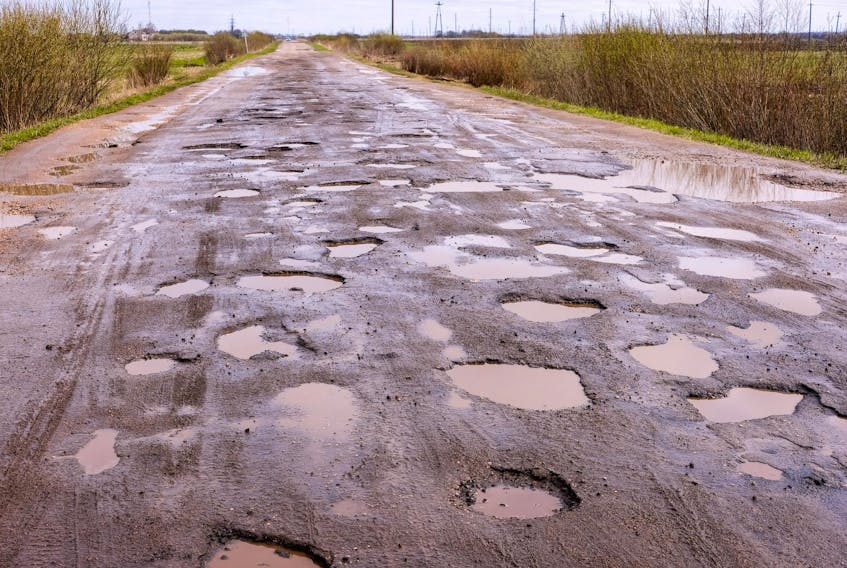Welcome to pothole season. It is that time of year when we look forward to warmer temperatures, greener lawns and fewer layers of clothes.
We also have to start looking further ahead while at the wheel, watching for and trying to avoid those nasty canyons in the road — potholes.
A recent American study put vehicle repair costs for damage caused by potholes and other dangerous road conditions at $4.8 billion.
“That’s almost four times the $1.3 billion a year spent on road repairs by state highway departments,” according to a 1997 report from the Environmental Working Group and Surface Transportation Policy Project.
Any driver is aware of the tremendous shock caused by striking a pothole. What you might not realize is that one single incident may not cause damage that requires repair, but the cumulative effect of striking more than one may.
Potholes are common around the world, but more frequent and severe in areas where there is a repeated freeze-thaw cycle. Potholes form when the surface, either concrete or pavement, develops fatigue and cracks.
These cracks soon develop into an interlocking pattern known within the industry as “alligator cracking.” Moisture from rain or melting ice or snow seeps into these cracks.
Since water expands when it freezes, when the temperature drops this moisture freezes and expands, pushing the various pieces apart and up.
As vehicles pass over these weakened areas, the individual chunks work loose and are picked out of the surface as vehicle pass over, forming a hole.
Once a pothole is crated, it grows like a bad weed as more and more chunks of pavement or concrete work loose, and are pulled out. When the pothole fills with water the problem is exacerbated as the water washes away smaller loose pieces.
The problem is particularly bad this time of year not only because of the freeze-thaw cycle, but because the sub grade on which the pavement or concrete is laid is weakened due to a very high moisture content.
There is nothing motorists can do to prevent potholes. All we can do its try to avoid them or at least minimize the potential damage to tires, wheels, suspension components and the undercarriage of our vehicle.
AVOIDANCE
a) Look well down the road to allow early sightings.
b) Travel on familiar roads.
c) Try to stick to well-lit roads at night.
d) If you are unable to miss one, do your braking before you hit it. Hitting a pothole with the wheel locked will greatly increase the likelihood or degree of damage.
e) Watch traffic ahead of you for signs other drivers are taking evasive action or slowing suddenly. This may be a tipoff to a pothole situation.
f) Be careful when trying to avoid a pothole that you do not lose control of your vehicle or move into adjacent lanes or traffic.
DAMAGE
a) If you strike a pothole with sufficient force to feel it through the steering wheel stop at the first opportunity, and inspect the wheel and tire for visible signs of damage. Is a wheel cover missing? The wheel may have flexed enough to have one pop off and they can cost hundreds of dollars so recovering it now, would be a good idea. Look for bulges in the sidewall or cracks or dents in wheels — alloy wheels may look nice, but most are not capable of absorbing as much damage as a plain old steel wheel. Check both the inside and outside of the wheel/tire.
b) Check beneath your vehicle for obvious signs of damage.
c) After striking a nasty pothole, pay particular attention to the feedback the suspension is providing through the steering wheel. Is there a vibration; does the steering feel like it want to pull to one side?
d) Keep an eye open for different behaviour. Does the vehicle sway when you make a sudden turn? Does the nose dive when you brake or the rear squat under acceleration?
e) Remember, one pothole may not cause noticeable damage, but the cumulative effect of many may.
FOLLOW-UP
a) Report major potholes to appropriate traffic or road jurisdictions. Some may assume responsibility for pothole damage, and most will make every effort to make temporary repairs. Generally speaking, responsibility for avoiding a pothole and subsequent damage from striking one, falls upon the motorist.
b) If the damage is sufficient, report it to your insurance company. You may be covered under the collision portion of your policy. But remember the cost of the deductible and possible effect on your rates. Damage to tires will likely not be covered — that comes under road hazard insurance on the tires, if you have it.









